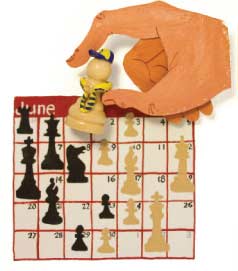
Your Best Move
Why an effective planning conference builds a winning program.
Illustration by Dave Wheeler
 |
THE MOST IMPORTANT meeting of the Cub Scout year doesn't involve any Cub Scouts at all. Instead, the meeting—the pack's annual planning conference—gathers leaders and parents to ensure that their Cub Scouts have plenty to look forward to in the year ahead.
But perhaps we're getting ahead of ourselves.
Pack Trainer Jamie Niss Dunn of Pack 512 in Blaine, Minn., says the planning conference should start with a thorough review of the current program year—not with setting dates and filling out calendar grids. "It's easy to just recycle what we did last year," she says. "But that's not planning. That's just doing the calendar."
Discuss which events worked well, what's gotten stale, and what you could add to the program. "It's easy to fall into the pattern of saying, 'In September, we have our roundup. In October, we have a Halloween party. In November, we have a hayride. In December, we have a Christmas party.'" Dunn says. "That gets stale fast by the time you're in fourth grade and you've done the same thing over and over again for four years in a row."
Once you've evaluated this year's program, think about goals for next year. How many boys do you want to recruit? Which areas—camping, the religious-emblems program—need more attention next year? Which events will the budget support, and how can you raise more money if you need it?
Only then should you start setting dates for meetings, outings, and activities. Here, it's crucial to do your homework. Assemble calendars from local schools, your chartered organization, and your district and council and highlight any activities you want to include (the pinewood derby) or conflicts you want to avoid (major holidays). Also, look for opportunities to piggyback on existing events. If your chartered organization holds a fall festival, for example, consider setting up a booth there to promote your pack, sell popcorn, or teach basic first aid.
Some Scouters do even more homework. In Pack 152 in Lexington, Ohio, Pack Secretary Sarah Kuhn brings a tentative calendar to the planning conference that includes suggested dates for things like pack meetings and committee meetings.
As you plan your calendar, don't just set dates. Though it's good to know that the pinewood derby will be on Saturday, Jan. 28, it's better to also know who will be coordinating it. And it's even better to know that there's money in the pack budget for needed supplies.
Making all those decisions at the planning conference requires plenty of participation, which is why you should invite all pack parents. "Trying to get parents to come and participate is a way for you to gauge interest and identify potential volunteers," Dunn says.
You'll also need plenty of time. Three hours on a Saturday morning or Sunday afternoon should suffice, if you've done your homework and stay on track. "Some of the first ones we had ran four to six hours," recalls Kuhn. "That's ugly."
Although summer seems the logical time to meet, late spring is better. Kuhn's pack likes to distribute its calendar in May because many pack families take summers off from Scouting. "They know when we're going to start back up in the fall," she says. "It shows that the program never dies off."
At the very least, prepare your calendar early enough so that you can distribute it at fall roundup. "One of the things you want to do when you're persuading new families to join the pack is say, 'We have our act together. We know what we're doing,'" Dunn says. The calendar says that.
Promptly producing your calendar offers another benefit, says Kuhn. "If you're first on the family calendar, you're less likely to be replaced," she says. "It's harder to pencil in someone else on top of you if you're the first on the family calendar."